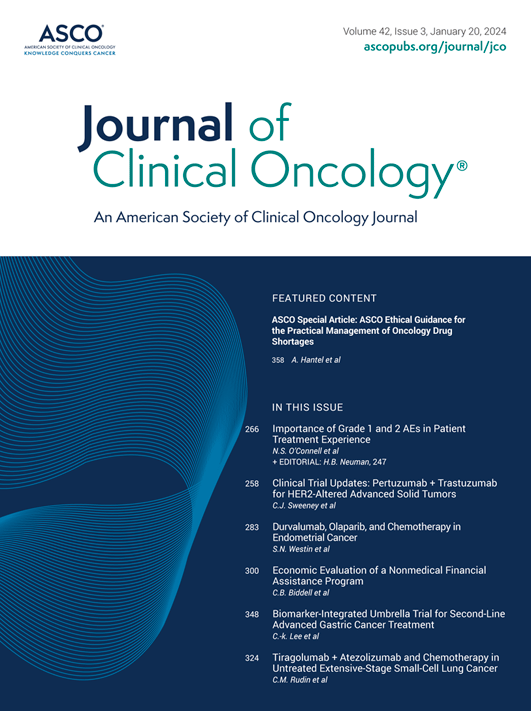Primary Analysis of EPIK-O/ENGOT-ov61: Alpelisib Plus Olaparib Versus Chemotherapy in Platinum-Resistant or Platinum-Refractory High-Grade Serous Ovarian Cancer Without BRCA Mutation.
IF 42.1
1区 医学
Q1 ONCOLOGY
引用次数: 0
Abstract
PURPOSE Patients with platinum-resistant/platinum-refractory high-grade serous ovarian cancer (HGSOC) without a BRCA mutation have poor prognosis and limited treatment options. We report efficacy and biomarker data from EPIK-O, which investigated alpelisib + olaparib versus single-agent chemotherapy in these patients. PATIENTS AND METHODS EPIK-O was an open-label, phase III trial that randomly assigned patients with platinum-resistant/platinum-refractory HGSOC with no germline or known somatic BRCA mutation 1:1 to alpelisib 200 mg once daily + olaparib 200 mg twice daily or treatment of physician's choice (TPC; paclitaxel 80 mg/m2 once weekly or pegylated liposomal doxorubicin 40-50 mg/m2 once every 28 days). Patients had 1-3 previous systemic therapies. Previous bevacizumab was required (unless contraindicated); previous poly(adenosine diphosphate-ribose) polymerase inhibitors were allowed. Primary end point was progression-free survival (PFS) per RECIST 1.1 (blinded independent review committee [BIRC]). Secondary efficacy end points included overall response rate (ORR; per BIRC), duration of response (per BIRC), and overall survival (OS; key secondary end point). RESULTS A total of 358 patients (alpelisib + olaparib [n = 180], TPC [n = 178]) were included. The median follow-up time was 9.3 months. At data cutoff (April 21, 2023), 33 (18.3%) and 30 (16.9%) patients remained on treatment with alpelisib + olaparib and TPC, respectively. The median PFS (BIRC) was 3.6 versus 3.9 months (hazard ratio [HR], 1.14 [95% CI, 0.88 to 1.48]; one-sided P = .84) for alpelisib + olaparib versus TPC. The ORR was 15.6% (95% CI, 10.6% to 21.7%) versus 13.5% (95% CI, 8.8% to 19.4%). The median OS was 10.0 versus 10.6 months (HR, 1.22; 95% CI, 0.87 to 1.71). The safety profile of alpelisib + olaparib was consistent with that observed for the individual agents. CONCLUSION The primary objective, PFS improvement, was not met in EPIK-O. No new or unexpected adverse events were observed. Biomarker analyses provided new insights for responders to alpelisib + olaparib.EPIK-O/ENGOT-ov61的初步分析:Alpelisib加奥拉帕尼对无BRCA突变的铂耐药或铂难治的高级别浆液性卵巢癌的化疗
目的:无BRCA突变的铂耐药/铂难治高级别浆液性卵巢癌(HGSOC)患者预后差,治疗选择有限。我们报告了EPIK-O的疗效和生物标志物数据,该数据研究了这些患者的alpelisib + olaparib与单药化疗的对比。患者和方法:sepik - o是一项开放标签III期试验,随机分配无种系或已知体细胞BRCA突变1:1的铂耐药/铂难治HGSOC患者至alpelisib 200 mg每日1次+奥拉帕尼200 mg每日2次或医生选择治疗(TPC;紫杉醇80 mg/m2每周1次或聚乙二醇化脂质体阿霉素40-50 mg/m2每28天1次)。患者既往接受过1-3次全身治疗。既往需要使用贝伐单抗(除非有禁忌症);先前的聚二磷酸腺苷核糖聚合酶抑制剂是允许的。主要终点是RECIST 1.1(盲法独立审查委员会[BIRC])的无进展生存期(PFS)。次要疗效终点包括总有效率(ORR);每个BIRC)、反应持续时间(每个BIRC)和总生存期(OS;关键次要终点)。结果共纳入358例患者(alpelisib + olaparib [n = 180], TPC [n = 178])。中位随访时间为9.3个月。截至数据截止日期(2023年4月21日),分别有33例(18.3%)和30例(16.9%)患者仍在接受alpelisib + olaparib和TPC治疗。中位PFS (BIRC)分别为3.6个月和3.9个月(风险比[HR], 1.14 [95% CI, 0.88至1.48];alpelisib + olaparib与TPC的单侧P = 0.84)。ORR分别为15.6% (95% CI, 10.6% - 21.7%)和13.5% (95% CI, 8.8% - 19.4%)。中位OS为10.0 vs 10.6个月(HR, 1.22;95% CI, 0.87 ~ 1.71)。alpelisib + olaparib的安全性与单个药物的观察结果一致。结论EPIK-O未达到改善PFS的主要目的。未观察到新的或意外的不良事件。生物标志物分析为alpelisib + olaparib应答者提供了新的见解。
本文章由计算机程序翻译,如有差异,请以英文原文为准。
求助全文
约1分钟内获得全文
求助全文
来源期刊

Journal of Clinical Oncology
医学-肿瘤学
CiteScore
41.20
自引率
2.20%
发文量
8215
审稿时长
2 months
期刊介绍:
The Journal of Clinical Oncology serves its readers as the single most credible, authoritative resource for disseminating significant clinical oncology research. In print and in electronic format, JCO strives to publish the highest quality articles dedicated to clinical research. Original Reports remain the focus of JCO, but this scientific communication is enhanced by appropriately selected Editorials, Commentaries, Reviews, and other work that relate to the care of patients with cancer.
 求助内容:
求助内容: 应助结果提醒方式:
应助结果提醒方式:


